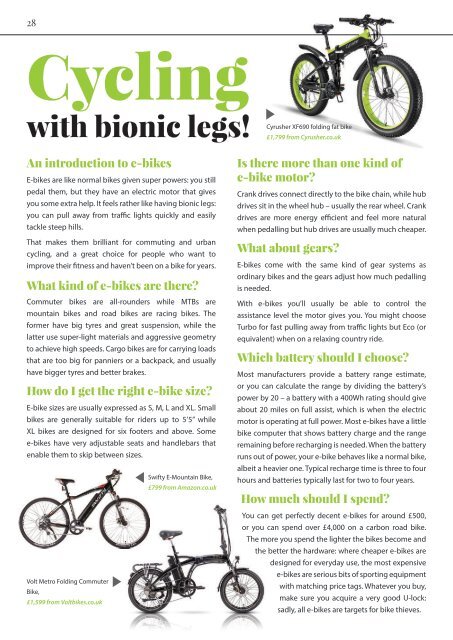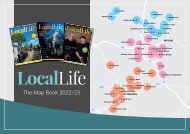You also want an ePaper? Increase the reach of your titles
YUMPU automatically turns print PDFs into web optimized ePapers that Google loves.
28<br />
Cycling<br />
with bionic legs!<br />
Cyrusher<br />
XF690 folding fat bike<br />
£1,799 from Cyrusher.co.uk<br />
An introduction to e-bikes<br />
E-bikes are like normal bikes given super powers: you still<br />
pedal them, but they have an electric motor that gives<br />
you some extra help. It feels rather like having bionic legs:<br />
you can pull away from traffic lights quickly and easily<br />
tackle steep hills.<br />
That makes them brilliant for commuting and urban<br />
cycling, and a great choice for people who want to<br />
improve their fitness and haven’t been on a bike for years.<br />
What kind of e-bikes are there?<br />
Commuter bikes are all-rounders while MTBs are<br />
mountain bikes and road bikes are racing bikes. The<br />
former have big tyres and great suspension, while the<br />
latter use super-light materials and aggressive geometry<br />
to achieve high speeds. Cargo bikes are for carrying loads<br />
that are too big for panniers or a backpack, and usually<br />
have bigger tyres and better brakes.<br />
How do I get the right e-bike size?<br />
E-bike sizes are usually expressed as S, M, L and XL. Small<br />
bikes are generally suitable for riders up to 5’5” while<br />
XL bikes are designed for six footers and above. Some<br />
e-bikes have very adjustable seats and handlebars that<br />
enable them to skip between sizes.<br />
Swifty E-Mountain Bike,<br />
£799 from Amazon.co.uk<br />
Volt Metro Folding Commuter<br />
Bike,<br />
£1,599 from Voltbikes.co.uk<br />
Is there more than one kind of<br />
e-bike motor?<br />
Crank drives connect directly to the bike chain, while hub<br />
drives sit in the wheel hub – usually the rear wheel. Crank<br />
drives are more energy efficient and feel more natural<br />
when pedalling but hub drives are usually much cheaper.<br />
What about gears?<br />
E-bikes come with the same kind of gear systems as<br />
ordinary bikes and the gears adjust how much pedalling<br />
is needed.<br />
With e-bikes you’ll usually be able to control the<br />
assistance level the motor gives you. You might choose<br />
Turbo for fast pulling away from traffic lights but Eco (or<br />
equivalent) when on a relaxing country ride.<br />
Which battery should I choose?<br />
Most manufacturers provide a battery range estimate,<br />
or you can calculate the range by dividing the battery’s<br />
power by 20 – a battery with a 400Wh rating should give<br />
about 20 miles on full assist, which is when the electric<br />
motor is operating at full power. Most e-bikes have a little<br />
bike computer that shows battery charge and the range<br />
remaining before recharging is needed. When the battery<br />
runs out of power, your e-bike behaves like a normal bike,<br />
albeit a heavier one. Typical recharge time is three to four<br />
hours and batteries typically last for two to four years.<br />
How much should I spend?<br />
You can get perfectly decent e-bikes for around £500,<br />
or you can spend over £4,000 on a carbon road bike.<br />
The more you spend the lighter the bikes become and<br />
the better the hardware: where cheaper e-bikes are<br />
designed for everyday use, the most expensive<br />
e-bikes are serious bits of sporting equipment<br />
with matching price tags. Whatever you buy,<br />
make sure you acquire a very good U-lock:<br />
sadly, all e-bikes are targets for bike thieves.


















